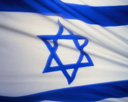 As big sister, I accompany two of my five younger siblings to the roof of our 14-story building. We head up there whenever we can, even if people say it makes us easy targets. We climb 13 floors of stairs just to stand and look out on Gaza and breathe in 15 minutes of air before we duck inside again. “Burning City,” the children call it. Columns of smoke rise from various locations in the distance changing the color of the sky and the sun. The entire landscape is transformed. We can make out the locations of several of the many public, residential and landmark buildings that have been turned to piles of rubble. Israeli tanks now block the roads where we used to drive along the coast. Dark, ominous warships look out of place so close to our beautiful Gaza shore, which had been one of the only escapes and source of relaxation for the besieged people of the Gaza Strip. Earthen barriers have risen in the Zatoun area, cutting off the densely populated, heavily bombarded neighborhood from the rest of the city.
As big sister, I accompany two of my five younger siblings to the roof of our 14-story building. We head up there whenever we can, even if people say it makes us easy targets. We climb 13 floors of stairs just to stand and look out on Gaza and breathe in 15 minutes of air before we duck inside again. “Burning City,” the children call it. Columns of smoke rise from various locations in the distance changing the color of the sky and the sun. The entire landscape is transformed. We can make out the locations of several of the many public, residential and landmark buildings that have been turned to piles of rubble. Israeli tanks now block the roads where we used to drive along the coast. Dark, ominous warships look out of place so close to our beautiful Gaza shore, which had been one of the only escapes and source of relaxation for the besieged people of the Gaza Strip. Earthen barriers have risen in the Zatoun area, cutting off the densely populated, heavily bombarded neighborhood from the rest of the city.
Our entire lives is now one long chaotic stream of existence: waiting in line each morning to fill up containers with water from the only working tap on the ground floor of our building, baking homemade bread from the depleting supply of flour we managed to obtain a few days into the offensive, turning on the power generator for 30 to 50 minutes in the evening to charge phones and watch the news. Meanwhile, the constant in our lives has become the voice of the reporter on the small transistor radio giving reports every few seconds of the location and resulting losses from the explosion we just heard, or other attacks farther off on the Strip.
Source: By Safa Joudeh Time
Filed under: Voice, Gaza, Gaza strip, Hamas, IAF, IDF, Israel, Middle East, Operation Cast Lead, Palestine, Terror, Terrorism, The Terror Journal, Voice, War

 Israeli forces pushed into the Gaza Strip’s most populous area on Sunday, killing at least 31 Palestinians on the 16th day of a devastating offensive Israeli Prime Minister Ehud Olmert said was close to achieving its aims.
Israeli forces pushed into the Gaza Strip’s most populous area on Sunday, killing at least 31 Palestinians on the 16th day of a devastating offensive Israeli Prime Minister Ehud Olmert said was close to achieving its aims. “When you see civilians, whether Palestinian or Israeli, harmed, under hardship, it’s heartbreaking. And obviously what that does is it makes me much more determined to try to break a deadlock that has gone on for decades now,” he told ABC’s “This Week.”
“When you see civilians, whether Palestinian or Israeli, harmed, under hardship, it’s heartbreaking. And obviously what that does is it makes me much more determined to try to break a deadlock that has gone on for decades now,” he told ABC’s “This Week.” The biggest political loser in the battle of wills between Israel and Hamas that continues to rage in Gaza is the Palestinian Authority of President Mahmoud Abbas. Even as Western and Arab diplomats take care to assign the increasingly marginalized Abbas a role in negotiations over a truce to end the fighting that has claimed more than 700 lives, he is facing mounting fury from Palestinians, not only in Gaza but also in his West Bank stronghold. When the blistering sermons and Friday prayers were done, several thousand inhabitants of Ramallah, the Palestinian Authority’s West Bank seat of power, gathered in the city’s central square for what organizers had billed as a demonstration of Palestinian unity against the Israeli offensive in Gaza. But Palestinian unity is wearing pretty thin.
The biggest political loser in the battle of wills between Israel and Hamas that continues to rage in Gaza is the Palestinian Authority of President Mahmoud Abbas. Even as Western and Arab diplomats take care to assign the increasingly marginalized Abbas a role in negotiations over a truce to end the fighting that has claimed more than 700 lives, he is facing mounting fury from Palestinians, not only in Gaza but also in his West Bank stronghold. When the blistering sermons and Friday prayers were done, several thousand inhabitants of Ramallah, the Palestinian Authority’s West Bank seat of power, gathered in the city’s central square for what organizers had billed as a demonstration of Palestinian unity against the Israeli offensive in Gaza. But Palestinian unity is wearing pretty thin. A few days ago, Physicians for Human Rights began soliciting $700,000 in donations for hospitals in the Gaza Strip. The Israeli humanitarian organization also provided a detailed list of the medical equipment Gaza lacks, including portable monitors, respirators, ultrasound and X-ray machines, wheelchairs, needles, dressings, catheters, oxygen, medical gases, endo-tracheal tubes, screws and plates for shattered limbs, and surgical gloves. According to PHR, Gaza also has a severe shortage of intensive-care beds, which cost about $50,000 apiece. Moreover, many Palestinian ambulances are out of commission.
A few days ago, Physicians for Human Rights began soliciting $700,000 in donations for hospitals in the Gaza Strip. The Israeli humanitarian organization also provided a detailed list of the medical equipment Gaza lacks, including portable monitors, respirators, ultrasound and X-ray machines, wheelchairs, needles, dressings, catheters, oxygen, medical gases, endo-tracheal tubes, screws and plates for shattered limbs, and surgical gloves. According to PHR, Gaza also has a severe shortage of intensive-care beds, which cost about $50,000 apiece. Moreover, many Palestinian ambulances are out of commission. Tens of thousands of people, in cities all over Europe, have been demonstrating against the Israeli offensive in Gaza.
Tens of thousands of people, in cities all over Europe, have been demonstrating against the Israeli offensive in Gaza. Hamas tried to shoot down an IAF plane at the weekend using an anti-aircraft missile, the air force said during a briefing it held on Sunday.
Hamas tried to shoot down an IAF plane at the weekend using an anti-aircraft missile, the air force said during a briefing it held on Sunday. As the Israeli raids on Gaza and Palestinian rocket attacks on southern Israel continue, BBC Middle East editor Jeremy Bowen assesses why both Israel and Hamas seem likely to pursue the conflict.
As the Israeli raids on Gaza and Palestinian rocket attacks on southern Israel continue, BBC Middle East editor Jeremy Bowen assesses why both Israel and Hamas seem likely to pursue the conflict. New York Times UN bureau chief who now works at the International Peace Institute, a think-tank that conducts research on UN affairs and conflict resolution. The US vetoed an earlier Security Council statement, proposed by Libya, condemning the outbreak of violence in Gaza, objecting to the “unbalanced” equation of Hamas shelling with the Israeli military operation
New York Times UN bureau chief who now works at the International Peace Institute, a think-tank that conducts research on UN affairs and conflict resolution. The US vetoed an earlier Security Council statement, proposed by Libya, condemning the outbreak of violence in Gaza, objecting to the “unbalanced” equation of Hamas shelling with the Israeli military operation



Recent Comments